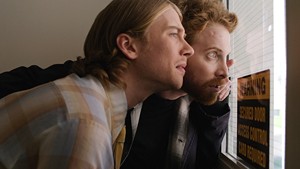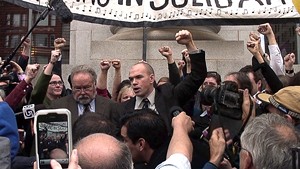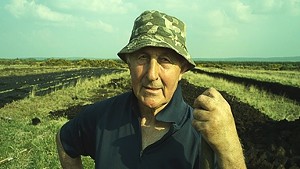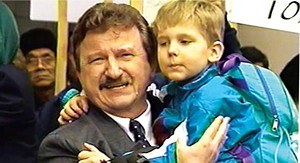I love this time of year.

I love meeting actors and filmmakers. I love serving on the judges’ panel. I love attending parties and eating cheese with film buffs. Like any journalist, I love any chance to wear a lanyard around my neck, knowing afterward I can add it to my prized collection, pretending not to notice how greatly this impresses my peers. I even kind of love standing in line, the palpable anticipation and momentary chaos of the activity seeming to contain a promise that something remarkable is about to happen, because the San Luis Obispo International Film Festival is back, dammit!
But more important still, eclipsing all the lanyards and cheese, are the films. This being a festival—and a chance to experience work from new, unknown, or independent filmmakers—some of this year’s films are fantastic. Some are not. But experiencing many different approaches to the craft, forming one’s own opinions, and discussing them with other moviegoers is the great benefit of a festival, and the kind of thing that helps the viewer and the filmmaker think critically about what actually makes a great film successful. And if a selection makes you wonder what the hell is going on inside a filmmaker’s head, well, you can usually ask him or her after the screening.
Peruvian writer-director Alonso Mayo’s feature debut The Story of Luke, an indie starring the wonderfully gifted and sympathetic Lou Taylor Pucci, was one such film, and my attempt to get inside his head is below, as are my impressions of several selections from the documentary and shorts categories, which you are most welcome to disagree with.
The Story of Luke isn’t the only film of its category to stand out. Director Kevin Tierney’s French Immersion, a bilingual comedy set in a language immersion school in a small town in Quebec, is a charming, witty, and often hilarious selection that many will enjoy—though its resolution to the many subplots it keeps going doesn’t quite satisfy. Swiss writer-director Peter Luisi’s Boys Are Us—which follows two Zurich teenagers through the often-cruel world of online dating—employs an extremely bizarre narrative trick that, though ultimately confusing, is nonetheless a compelling experiment.
Yet The Story of Luke, which was filmed in Ontario in a town that could just as easily be anywhere in the United States, stands a head above the rest. Unlike many selections, it doesn’t promise anything it can’t deliver. Instead, it takes an understated premise and a noble central character and patiently builds something of great poignancy and humor.
Lou Taylor Pucci is Luke, a young autistic man who has been mostly raised by his grandparents. Upon his grandmother’s death, and his grandfather Jonas’ (a fantastically curmudgeonly Kenneth Welsh) admittance into a convalescent home, Luke decides it’s time to find a job so he can live on his own and screw. Yes, he says that, and in the most earnest, heartfelt way possible, chin held high. Luke doesn’t quite have the same feeling for context, irony, or the nuances of language most people do. But through Pucci’s performance as the guileless main character, and Mayo’s extraordinary gift for dialogue, this trait makes for some of the funniest moments in the film. When Luke does find work, he’s confronted by Zack (an outstanding Seth Green), another character on the spectrum who, through careful study of “neurotypicals,” manages at first not to appear disabled, but rather comically deranged.

In Luke, Pucci and Mayo create an endearing and fully realized character, granting viewers a glimpse into the autistic mind that never sinks into pity or parody. This isn’t a film about a disability; it’s about a young man with struggles, just like everyone else.
Running time is 95 minutes. See it Friday, March 8, at 7 p.m. at Downtown Cinemas, or Sunday, March 10, at 1 p.m. at La Perla Del Mar.
SUN When did you first get the idea to create a film with an autistic protagonist?
ALONSO MAYO It’s kind of been brewing for a very long time. My mom ran a school for kids with disabilities in Peru, where I’m from. So I grew up around them, around the families, around the professionals that helped them, so it was just kind of natural. I worked there a while when I was growing up, too, so I’ve always been around it. I actually started filmmaking because our school got a grant to make training videos for teachers. So that’s the first time I got my hands on cameras or any equipment like that. So I was involved with it for a very long time, and then I decided I wanted to do a film. The stuff I’ve done before is very, very different. It’s probably the lightest movie I’ve done so far. I’ve done dramas, thrillers, stuff like that. So it was kind of a challenge for me, because I knew if I ever did a movie about this subject, I wanted it to be light. I didn’t want it to be this heavy, heavy, heavy drama. It’s easy for movies about disabilities to do that. And then I got involved with a lot of young adults that started going into the workplace, and I think that’s where things started to click for me. I saw all these adults that I’d seen growing up, and it was amazing to see them flourish. But then, they started to have, kind of, normal people problems, you know? Like girlfriends, and living by yourself. It was very interesting to see, and I wanted to make a movie about someone who starts asking himself these questions.
SUN How much of the character of Luke was developed by the actor, Lou Taylor Pucci, and how much was your direction and vision for the character?
MAYO All movies are a collaboration between the performer and the director, and Lou Taylor Pucci was just amazing. He’s a great actor. I knew his work from before, so I was thrilled that he came to the project. He got in early, so it actually helped us get the other cast together because they respected him so much. They knew he would do the work, you know. And it was a lot of work. We had a lot of rehearsals. There was a lot of research he did. He met a lot of men and women on the spectrum. He really did his homework. I think about three weeks before we shot, we actually had a full week where we did some research together and rehearsed, and we kind of nailed it, you know. We nailed the right balance. He had to find a way to portray this character—first, to be authentic, you know, we didn’t want to make a cartoon. But we also needed to play it light enough. It was a balance. We were quite nervous for a long time until we finally found that.

SUN That, I think would be a challenge: not making a caricature of the character. He walks a different way; he moves his arms a different way. It can be funny—and it should be funny—but it shouldn’t be making fun. I imagine you would just have to work with a lot of different gestures before getting it right.
MAYO There was a lot of trial and error. It’s a wide spectrum, so every single individual shows it in a different way. He had to kind of piece together things he’d seen and experienced through a lot of different people and kind of build his own way of doing it.
SUN Another thing I liked about Luke was the way he dressed himself. I don’t know if this was your intention, but his way of dressing and the way he wears his hair, it has this kind of—it’s nerdy, but it’s almost accidentally hipster.
MAYO We made the observation that he’s lived with his grandparents his whole life, and his grandparents are really the ones that raised him and formed him as a person, so he’s kind of old-fashioned. He’s inherited the clothes that his grandpa probably would have worn at his age. So it is kind of all a little bit retro. But more like retro retro. Kind of the ’50s and early ’60s, that’s kind of where those choices came from. In a way, he’s like somebody from that past that just walks in 2013, into modernity.
SUN Some of the supporting actors were a kind of special treat, almost like an inside joke for lovers of cult classics, because you know them best as a certain character—there’s Wesley from The Princess Bride, Windom Earle from Twin Peaks. And yet you use the actors in a very different way, which I think is quite charming.
MAYO I think that’s why a lot of them were interested in this, that they’re doing something they haven’t done before. Like Seth Green, he’s done a lot of stuff, but most of it has been comedy. So for him, even though our production is considered a light comedy, it was one of the more dramatic things he’d done.

SUN As both the writer and director, how do you maintain a critical eye, and the ability to edit yourself, when you’re so surrounded by your own work?
MAYO I guess the first thing is, you have to know when to change hats, right? When you’re a writer, you’ve got your writer’s hat on, and when you’re a director, you’ve got to throw the writer’s hat out, you know? When you’re in the editing room, same thing. I have written and directed a lot of stuff before, and the main thing is to surround yourself with great people. I had this great crew who helped me make it happen and made sure I didn’t make a fool out of myself. We had a lot of tough choices. It was tough that, in production, for budget reasons, we had to cut a lot of days. We had to cut a bunch of scenes out. It hurts, but at the end of the day you have to keep what’s good for the movie. You just have to be brutal with the material to make sure you end up with something that is tight and entertaining. Our first cut, I think, was three hours! Sometimes you have to cut good stuff, just to keep the comedy right. You can’t really love your material as much as you love your audience. You have to make sure something’s really watchable and cool, and not just stuffed in there because you think it’s so precious.
SUN I was so impressed by the dialogue. Aside from the performances themselves, I thought that was the strongest thing. I’m wondering, how did you get it right? What inspiration did you have to work from?
MAYO For Luke, I’ve just been around a lot of people with autism. You hear a lot of funny things, because sometimes they just don’t have a filter that most people have, where you try to edit yourself before you say it. And that can be very refreshing. I’ve been around it enough that I started making mental notes of things to use in the movie. For the other characters, they were fun to write because I didn’t want to make them very extreme. The challenge for me was, I had my protagonist, Luke, who to me was the hero of the movie, and I wanted to make him the most normal person in the movie, even though he was the one with a disability. So that’s where I started. All these other characters, they could be caricatures, you know, they could be more out there. Cindy could be a real bitch, you know. I kind of put all the dysfunction that I could into everyone around him.
SUN I actually admired the fact that the Aunt Cindy character, I thought she was just going to be a bitch the whole time, and I was ready to hate her, so when she started to become sympathetic, I was a bit conflicted. I thought that was a mature choice.
MAYO That was kind of the point, that he changes people, just by the fact that he’s there.

SUN This being your first narrative feature, what did you learn from filming The Story of Luke?
MAYO A lot of people say that making films is kind of like making babies, you know, you can’t even see yourself the way you used to be before, because you’ve learned so much. It’s a lot of learning, it’s a lot of people to deal with, it’s getting a story arc and everything right. And then getting it out into the world, making sure it finds a good home and people end up seeing it, it’s just a lot.
SUN Did it change your approach to film to study the craft in Lima, as opposed to Los Angeles?
MAYO I don’t know. Honestly, I don’t know if it matters where you come from. One of the things I got a lot of growing up was just contrast. I grew up in Lima and came here to the U.S. and lived a long time in Kansas, so I kind of went back and forth, and saw a lot of things. I think in general for storytellers it’s good to see more than just what’s immediately around you, to see different cultures, to see different realities. Back home I was around a lot of poverty, and then I came here, to a set of different problems. I think those things definitely affect who you are, and the type of stories you want to tell.
Anna Weltner is arts editor of New Times, the Sun’s sister paper to the north. Contact her at [email protected].








